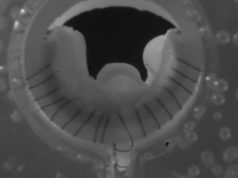In her presentation at the Royal Society of Medicine Venous Forum (RSMVF; 17–19 June, London, UK), consultant vascular surgeon Emma Wilton (Oxford University Hospitals, Oxford, UK) outlined the important process for identifying which patients with leg ulceration require deep venous intervention. Upon the suspicion of the obstructive venous pathology, Wilton argued that there are a number of steps which should be taken before treatment is applied, including imaging and an in-flow assessment.
Chronic venous insufficiency currently affects 7–9% of the UK population and is caused by such complications as valvular incompetence, chronic obstruction and calf pump failure, “all of which lead to the final pathway of elevated ambulatory venous pressure within the lower limb and venous hypertension,” according to Wilton. Other problems that can result in this insufficiency range from both superficial and deep venous reflux to causes of outflow obstruction, which include post-thrombotic syndrome and either malignant or non-malignant iliac veins.
Explaining the assessment procedure which should be followed in cases like this, Wilton said: “At our institution, we have a pathway for chronic obstructive venous disease. If suspected, the patient undergoes imaging, a multidisciplinary team meeting, clinic follow-up and further investigation before finally agreeing on treatment.”
The first clinical assessment stage involves an analysis of both the symptoms and signs of venous insufficiency, as well as a review of the patient’s history. Key areas of attention, as listed by the speaker during her presentation, comprise of aching or cramping, swollen limbs and skin discolouration, in addition to more obvious and immediate symptoms such as varicose veins and venous ulcers. Patients with either their own or a family history of venous disease should be noted, as well as any patient who has been an intravenous drug user in the past.
Following this initial review, the imaging stage is conducted. As Wilton describes, “first of all, everyone undergoes a venous duplex scan of the lower limb with a full assessment of deep and superficial systems”. This is said to highlight the presence of deep vein thrombosis, chronic scarring and venous reflux and helps to determine, or at least offer a suspicion, of deep venous disease.
The next step would involve a magnetic resonance venography or computed tomographic venography ranging from the upper thigh to the lower diaphragm. While the former aids with a clinical assessment of venous reflux and reveals the extent of occlusive disease, the latter helps to identify post-thrombotic stenotic change and can be performed on either directly or indirectly. In order to establish the adequacy of inflow vessels of patients identified as having venous disease, direct venography would also be performed.
By following this sequence of assessments, it becomes clearer which patients should receive treatment. Wilton said: “We would suggest that you treat patients with symptoms of chronic venous insufficiency that you can see is due to severe post-thrombotic syndrome or significant venous disease attributable to iliac veins and outflow obstruction.” Other factors that should influence the decision of whether or not to treat the patient include life expectancy, functional status and their bleeding risk. Pregnancy and ongoing intravenous drug use were also listed as contraindications to treatment.
Wilton concluded: “As mentioned, they need to have at least a good, if not adequate, inflow, they need to be able to be fully anticoagulated, they need to be compliant with their medication, and they need to be fully informed about the procedure and follow-up schedule, as well as the potential need for reintervention. You need to meet the criteria for intervention, it is not for everybody.”
On the potential of deep venous stenting for treating leg ulcers, she added: “The evidence is relatively limited, though here have been some retrospective case series looking at deep venous stenting and the healing up of leg ulcers, showing about a 60% healing rate.”












